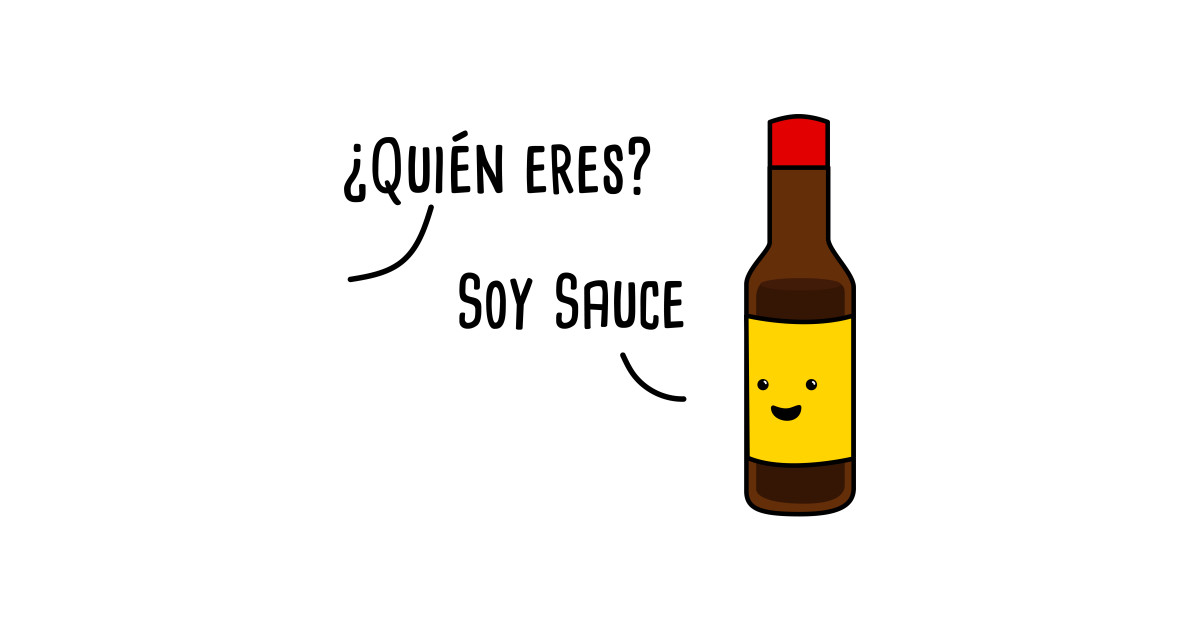As an avid foodie with a deep passion for both Spanish cuisine and the versatility of soy sauce, I couldn’t resist exploring the intriguing nuances of how to say this beloved condiment in Spanish.

Image: www.teepublic.com
My adventure began during a memorable culinary expedition in Barcelona, where I stumbled upon a bustling tapas bar. Eager to sample the local delicacies, I noticed a small, unassuming bowl of reddish-brown liquid labeled “salsa de soja.” Intrigued, I cautiously dipped a crispy croqueta into the sauce and was instantly transported to a realm of umami bliss. It was in that moment that I realized the importance of knowing how to navigate the Spanish culinary landscape with confidence, starting with mastering the art of ordering soy sauce.
Soy Sauce: Unlocking its Spanish Identity
In the vast tapestry of Spanish cooking, soy sauce holds a unique position. Known as “salsa de soja” or simply “soja,” this flavorful liquid has gracefully integrated itself into Spanish cuisine, enhancing countless dishes with its characteristic salty, savory notes.
Traditionally used in Japanese, Chinese, and Korean cuisine, soy sauce has transcended cultural boundaries, earning a place of honor in Spanish kitchens. Its versatility extends beyond Asian-inspired dishes, finding harmonious pairings in tapas, stews, and even paellas, contributing a subtle depth of flavor that tantalizes the palate.
Etymology and Evolution of Soy Sauce in Spanish
The term “salsa de soja” is a direct translation of the Chinese expression “shòuyù,” meaning “fermented soy liquid.” This etymology reflects the origins of soy sauce, which dates back centuries to ancient China, where it was first produced as a byproduct of tofu fermentation.
As trade routes expanded, soy sauce found its way to Japan, Korea, and eventually Spain. The Spanish word “soja” is derived from the Japanese pronunciation of the Chinese word “shōyu.” Over time, “soja” became widely adopted in Spanish, encapsulating the distinct flavor profile of this beloved condiment.
Comprehensive Guide to Soy Sauce in Spanish
To fully immerse yourself in the culinary delights of Spanish cuisine, it’s essential to master the intricacies of ordering and using soy sauce.
Pronunciation:
- “Salsa de soja” is pronounced as “sahl-sah day so-hah”
- “Soja” is pronounced as “so-hah”
Variants:
- Light soy sauce (salsa de soja ligera): A versatile, all-purpose soy sauce with a lighter color and less intense flavor.
- Dark soy sauce (salsa de soja oscura): A richer, thicker soy sauce with a darker color and a more robust flavor.
- Low-sodium soy sauce (salsa de soja baja en sodio): A reduced-sodium alternative, ideal for individuals watching their sodium intake.
Usage:
Soy sauce is an incredibly versatile condiment that can be used in a myriad of ways:
- As a dipping sauce for sushi, sashimi, and tempura.
- As a marinade for meats, fish, and vegetables.
- As a seasoning for stir-fries, noodles, and rice dishes.
- As a flavorful addition to soups, stews, and sauces.

Image: www.iga.net
Tips for Enhancing Your Soy Sauce Experience
To elevate your enjoyment of soy sauce, consider incorporating these expert tips:
- **Opt for high-quality soy sauce:** Look for brands that specify “naturally fermented” on the label, indicating traditional production methods.
- **Experiment with different varieties:** Explore the nuances of light, dark, and low-sodium soy sauces to find the perfect match for your taste preferences.
- **Use soy sauce sparingly:** A little bit goes a long way. Start with a small amount and gradually adjust to taste, avoiding overpowering the other flavors in your dish.
- **Consider using soy sauce as a finishing touch:** Adding a drizzle of soy sauce towards the end of cooking can enhance the umami profile without over-salting your dish.
Frequently Asked Questions about Soy Sauce in Spanish
To address common queries regarding soy sauce in Spanish, here’s a comprehensive Q&A:
- **Q:** How do you ask for soy sauce in a restaurant?
**A:** “Could I have some soy sauce, please?” – “¿Me podría traer salsa de soja, por favor?” - **Q:** What is the gluten-free alternative to soy sauce?
**A:** Tamari sauce is a gluten-free option made from soybeans, but without the addition of wheat. - **Q:** Can I make soy sauce at home?
**A:** While homemade soy sauce can be challenging, it can be rewarding. Extensive research and specialized equipment are required. - **Q:** What health benefits are associated with soy sauce?
**A:** Soy sauce contains antioxidants and is a good source of protein, but it should be consumed in moderation due to its high sodium content.
How To Say Soy Sauce In Spanish
Conclusion: Embracing the Flavors of Soy Sauce in Spanish
Learning how to say “soy sauce” in Spanish is a gateway to unlocking the culinary treasures of Spanish cuisine. By understanding its origins, variants, usage, and expert insights, you’ll elevate your culinary experiences and fully immerse yourself in the vibrant tapestry of Spanish flavors.
So, the next time you find yourself at a Spanish table, don’t hesitate to ask for “salsa de soja” and embark on a delightful culinary journey. As you savor the harmonious blend of flavors, remember the rich history and global influence that have shaped this versatile condiment.
Let us know in the comments below if you have any further questions or if you’d like to learn more about salsa de soja and its captivating role in Spanish gastronomy.